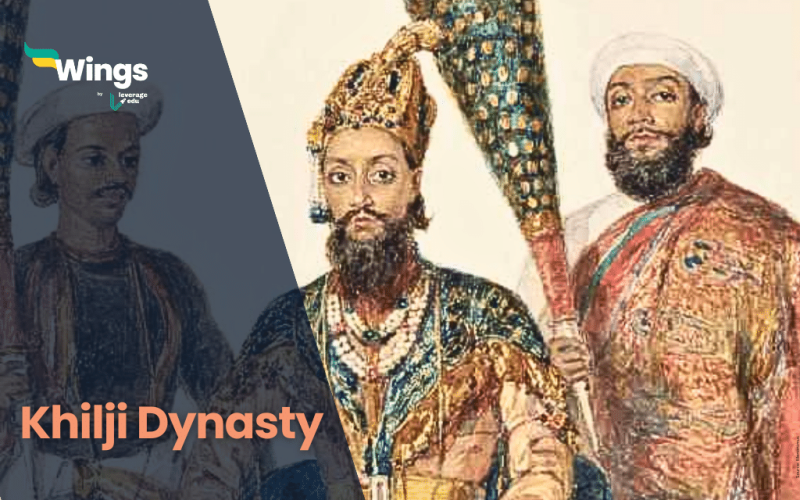The Khilji Dynasty or the Khaljis was the second dynasty of sultanate rulers in Delhi. For three consecutive decades from 1290 and 1320, the Khilji Dynasty ruled a large section of the Indian subcontinent. The top military commander of the Mamluk Dynasty Jalal-ud-din Khilji was the founder of this dynasty. In this blog, let us know more about this dynasty and learn about its origin, reigns, administration and succession.
Table of Contents
Origin
The last Mamluk ruler Kay-Qubādh appointed Jalal-ud-din Khilji despite him being from outside the ruling class. This gave rise to disapproval and Kay-Qubādh was soon killed in the crossfire to leave the throne to Jalal-ud-din Khilji. His nephew Juna Khan defeated Ellichpur captured its treasures and then killed Jalal-ud-din to assume the throne.
He furthered his expedition towards the Hindu-dominated Deccan India. He came to be known as Alaud-din-Khilji and captured areas like Ranthambhor (1301) and Chitor (1303), Mandu (1305) and Devagiri.

Rulers
There are some of the famous rulers of the Khilji Dynasty that are really popular. Each of them is mentioned hereunder.
- Jalal-ud-din Firoz Khilji (1290-1296 A.D.) – He was known to love peace and believed in non-violent rule. He also defeated the Mongols in 1292 A.D.
- Ala-ud-din Khilji (1296-1316 A.D.) – He plundered the west and southern India with invasions and conquering territories. He established a mosque in Rameshwaram and got the Deccan Indians to believe in his supremacy and pay him monetarily.
Also Read: Lodi Dynasty- Exploring India’s Medieval History
Administration
The rulers of the Khilji dynasty were not the same in the policies they followed. Alaud-din-Khilji and his uncle had different policies both are listed below.
Jalal-ud-din Khilji
- Suppressed the revolt by Malik Chhajju in Kara and appointed Ala-ud-din the governor of the area.
- He followed the policy of peace.

Ala-ud-din Khilji
- He appointed new governors Ulugh Khan and Nusrat Khan who conquered Gujarat.
- He also captured Ranthambore, Malwa, Chittor, Dhar, Mandu, Ujjain, Marwar, Chanderi and Jalor.
- Around 12 Mongol invasions were suppressed by Ala-ud-din Khilji.
- He followed the divine right of kingship and held on to the power.
- Four ordinances were introduced by him to avoid repeated revolts and he also reestablished the spy system.
- He installed a permanent standing army and banned parties and wine. He also made policies to inhibit corruption.
- He was the one to introduce a fixed price system below the market value to make goods affordable and also banned black marketing.
- Revenue was collected in cash and no kind.
Slavery
A large section of the population in the sultanate capital were slaves and concubines working for the Muslim nobles during the reign of Ala-ud-din Khilji. The Khilji Dynasty had two types of slaves; 1. War prisoners and 2. Tax defaulters. Slaves were addressed by names such as banda, qaid, ghulam, or burdah for males and bandi, kaniz or laundi for females.
Also Read: Sayyid Dynasty: UPSC Notes, History, Architecture, Economy
Succession
Two known rulers after Ala-ud-din Khilji were Qutb-ud-din Mubarak Shah (1316-1320 A.D.) and Nasir-ud-din Khusrav Shah (1320 A.D.). These were weak rulers and the then-governor of Punjab Ghazi Malik captured Delhi from them. He remanded himself Ghiyas-ud-din Tughluq and established the Tughlaq Dynasty.
Relevant Blogs
| Maratha Empire (1674-1818) | Satavahana Dynasty |
| The Vijaynagar Empire (1336-1647) AD | Pallava Dynasty |
| Hoysala Dynasty | Lodi Dynasty |
| Sunga Dynasty | Chola Dynasty |
| Kushan Dynasty | Chalukya Dynasty |
This blog was all about the Khilji Dynasty. If you want to read more articles like this, you can get Short notes on the Modern History of India here. Also, you can visit our general knowledge page on Indian History!
 One app for all your study abroad needs
One app for all your study abroad needs













